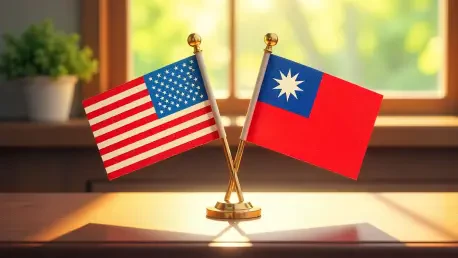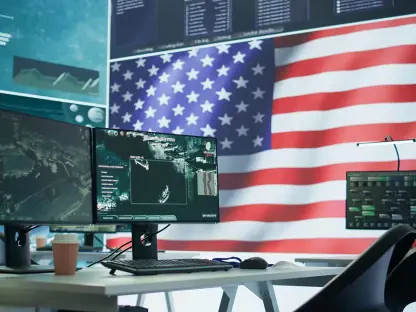Overview of U.S.-Taiwan Defense Dynamics
In an era marked by escalating tensions in the Indo-Pacific, the defense collaboration between the United States and Taiwan stands as a critical pillar of regional stability, particularly against the backdrop of China’s growing assertiveness. This partnership, rooted in decades of strategic alignment, has become a focal point for policymakers and industry leaders alike. The urgency to bolster Taiwan’s military capabilities through faster technology transfers has never been more pronounced, given the geopolitical stakes involved.
At present, the framework for U.S.-Taiwan defense cooperation operates under a complex set of policies and informal agreements, primarily guided by the Taiwan Relations Act of 1979. This legislation ensures U.S. support for Taiwan’s self-defense capabilities, despite the absence of formal diplomatic ties. Annual events like the U.S.-Taiwan Defense Industry Conference play a pivotal role in fostering dialogue among government officials, military experts, and private sector stakeholders, shaping the trajectory of arms sales and joint initiatives.
However, the current state of collaboration is not without significant challenges. Delays in arms deliveries, bureaucratic red tape, and differing priorities between immediate needs and long-term innovation continue to hinder progress. Addressing these issues is paramount to maintaining a credible deterrent in the region, prompting both nations to explore new avenues for streamlining defense technology transfers.
Understanding the Current State of U.S.-Taiwan Defense Collaboration
The foundation of U.S.-Taiwan defense ties rests on a shared commitment to counterbalance regional threats, particularly from China, which views Taiwan as part of its territory. This partnership facilitates the provision of defensive arms and technology to Taiwan, ensuring it can safeguard its sovereignty. Beyond mere transactions, the collaboration embodies a strategic alignment aimed at preserving peace and stability in the Taiwan Strait.
Key organizations, such as the US-Taiwan Business Council, serve as vital conduits for dialogue and advocacy, bridging gaps between governmental policies and industry capabilities. Events like the annual defense industry conference provide a platform for stakeholders to address pressing issues, from supply chain bottlenecks to policy constraints. These gatherings often yield actionable insights that influence U.S. legislative and executive approaches to arms sales.
Despite these efforts, the process of transferring defense technology faces persistent hurdles. Lengthy approval timelines and inter-agency coordination issues often delay critical deliveries, leaving Taiwan vulnerable to emerging threats. Overcoming these bureaucratic obstacles remains a top priority for both nations as they seek to enhance the efficiency of their defense cooperation.
Strategic Importance of Accelerating Defense Tech Transfers
Emerging Priorities and Policy Reforms
To address the growing urgency of defense support, the U.S. government is actively revising guidelines within the Defense and State Departments to expedite the consideration and release of critical technologies. These reforms aim to cut through red tape that has historically slowed down the transfer process. The focus is on creating a more responsive system that can meet Taiwan’s immediate security needs without compromising on thorough vetting.
Stakeholders on both sides recognize the importance of timely arms deliveries as a cornerstone of effective deterrence. Discussions at industry forums have underscored a mutual concern over delays that could undermine Taiwan’s readiness. The push for policy overhaul reflects a broader consensus that speed must be balanced with strategic alignment to ensure that transferred technologies are both relevant and sustainable.
A critical aspect of these reforms involves distinguishing between short-term requirements and long-term ambitions. While off-the-shelf equipment can address urgent gaps, there is also a need to invest in technology adaptation and potential co-development projects. This dual approach aims to fortify Taiwan’s defenses in the near term while building capacity for future innovation and self-reliance.
Taiwan’s Defense Investment Outlook
Taiwan’s proposed defense budget for 2026, coupled with a special allocation of up to NT$1 trillion (US$32.53 billion), signals a robust commitment to bolstering its military capabilities. This substantial financial pledge underscores a strategic intent to modernize and diversify its defense arsenal. The investment is poised to transform Taiwan’s security posture in response to evolving regional challenges.
Key areas of focus include the development of the T-Dome, a multi-layered air defense system designed to counter aerial threats, alongside enhancements in asymmetric warfare capabilities to deter unconventional attacks. Additionally, funds are earmarked for traditional platforms such as mobile artillery and helicopters, ensuring a comprehensive approach to national defense. These priorities align closely with U.S. technology transfer initiatives, promising a synergy that could amplify their impact.
Looking ahead, these investments are expected to strengthen Taiwan’s resilience against gray zone tactics and potential blockade scenarios. The alignment with U.S. support mechanisms suggests a shared vision for enhancing security through targeted technological advancements. Projections indicate that sustained funding and collaboration could significantly elevate Taiwan’s defense readiness over the coming years.
Challenges in Streamlining Defense Technology Transfers
The path to faster defense tech transfers is fraught with systemic obstacles, primarily stemming from bureaucratic inefficiencies. Lengthy approval processes within U.S. agencies often result in significant delays, impacting Taiwan’s ability to respond to immediate threats. These delays are compounded by the complexity of aligning military needs with export control regulations.
Moreover, while co-development and co-production of defense systems are often proposed as solutions to backlog issues, they are not quick fixes. Such initiatives require extensive coordination, technical integration, and time—resources that may not be readily available in urgent scenarios. Industry leaders have noted that these approaches, while valuable for long-term capacity building, cannot substitute for the rapid deployment of existing equipment.
To mitigate these challenges, prioritizing readily available systems for immediate needs could provide a temporary reprieve. Simultaneously, improving inter-agency coordination within the U.S. government and establishing clearer communication channels with Taiwanese counterparts might reduce procedural delays. Streamlining these processes will be essential to ensuring that defense transfers keep pace with evolving security demands.
Navigating the Regulatory and Political Landscape
Regulatory adjustments under consideration by the U.S. Defense and State Departments are geared toward simplifying the export of defense technologies to allies like Taiwan. These changes aim to create a more agile framework that can adapt to urgent requirements without sacrificing oversight. While specifics remain under wraps, the intent is clear: to minimize bottlenecks that hinder timely support.
Geopolitically, the U.S.-Taiwan defense relationship operates within a delicate balance influenced by U.S.-China dynamics. Beijing’s persistent claims over Taiwan and its opposition to foreign military support create a complex backdrop for cooperation. U.S. policy continues to navigate this tension by adhering to a stance that neither explicitly supports nor opposes Taiwan’s independence, maintaining a strategic ambiguity.
Political considerations, including potential diplomatic engagements between U.S. and Chinese leaders, could subtly impact defense collaboration. However, historical patterns suggest that such discussions often reinforce existing positions rather than provoke immediate policy shifts. This stability, while reassuring, necessitates vigilance to ensure that defense transfers to Taiwan remain unaffected by broader diplomatic currents.
Future Directions for U.S.-Taiwan Defense Ties
Accelerated defense technology transfers hold the potential to redefine the contours of U.S.-Taiwan military collaboration. By enhancing the speed and scope of support, both nations can better prepare for a spectrum of threats, from conventional warfare to hybrid challenges. This evolution could set a precedent for how allies collaborate on defense in high-stakes regions.
Emerging systems like the T-Dome are likely to play a central role in Taiwan’s future defense strategy, offering advanced protection against aerial incursions. Coupled with investments in asymmetric capabilities, these technologies signal a shift toward a more layered and adaptive security framework. U.S. expertise and resources will be instrumental in realizing the full potential of such innovations.
Nevertheless, external factors such as regional security developments and global economic conditions could pose risks to sustained cooperation. Disruptions in supply chains or shifts in political priorities might challenge the momentum of current initiatives. To counter these uncertainties, a focus on innovation, consistent funding, and strategic foresight will be vital to fortifying Taiwan’s defense posture with U.S. backing.
Building a Stronger Defense Partnership
Reflecting on the efforts to expedite defense technology transfers, it is evident that the U.S. has taken significant strides to address longstanding delays and align with Taiwan’s ambitious security goals. The synergy between policy reforms and Taiwan’s substantial defense investments has laid a promising foundation for enhanced collaboration. This partnership has grown stronger through a shared recognition of the need for both immediate solutions and enduring strategies.
Looking back, the emphasis on systems like the T-Dome and asymmetric warfare capabilities has marked a pivotal shift in Taiwan’s approach to national security, supported by U.S. technological expertise. Moving forward, actionable steps should include establishing dedicated task forces to streamline approval processes and foster real-time coordination between agencies. Additionally, exploring innovative financing models for joint projects could ensure sustained momentum.
As a final consideration, both nations should prioritize regular strategic dialogues to anticipate and mitigate geopolitical risks, ensuring that defense cooperation remains resilient amid global uncertainties. By focusing on adaptability and mutual trust, the U.S. and Taiwan can build on past achievements to create a defense partnership capable of addressing tomorrow’s challenges with confidence.









